As a relatively mature lightweight and high-strength alloy material, aluminum alloy is widely used in aerospace. Aluminum alloy material is generally used as a structural material, which has higher specific strength and better processing performance than steel.
In the aerospace field, aluminum alloy materials with high strength, high toughness and strong corrosion resistance are mainly developed to meet the harsh operating conditions of aerospace. The widely used alloy series are 2000 and 7000 aluminum alloys and Al-Li alloy materials.
The advantages of aluminum alloys for aerospace applications
- Higher static strength properties.
- Better corrosion resistance.
- Sufficiently high fracture toughness.
- Good fatigue resistance.
- good heat resistance.
- good overall performance.
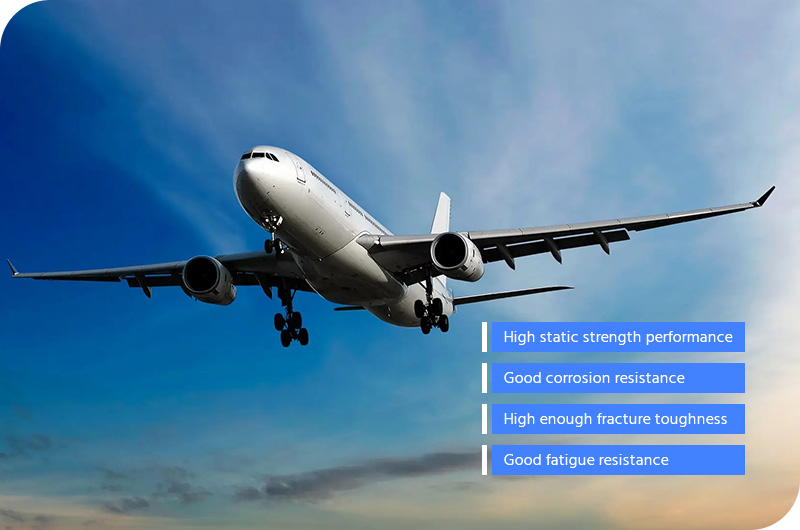
The application of aluminum sheet in aerospace
High-strength aluminum alloy sheets with excellent performance are mainly used in the aerospace field. Because aerospace products have extremely high requirements for weight reduction, aluminum alloy sheets with high specific strength are the preferred materials for aerospace. Among Aerospace aluminum sheets, 7000 series high-strength and high-toughness aluminum alloy sheets and 2000 series medium-strength and high-toughness aluminum alloy sheets play an important role.
The specifications of aluminum sheets for aerospace applications
2000 series of aerospace aluminum alloys
2017 T4 2024-T3 2224-T3511 2124-T851, 2324-T39 2024-T6, 2024-T8 2124-T851, 2224-T39 2524-T3
7000 series of aluminum alloy for aircraft
7075-T6 7178-T6 7079-T6 7075-T73 7075-T76 7475 7075-T74 7070-T74
7150-T6 7150-T61 7050-T74, 7050-T76 7150-T77 7055-T77
7475-T73, 7475-T76, 7075-T24, 7050-T7451, 7050-T7452, 7010-T74, and 7150-T61,
7150-T7751, 7150-T7751, 7055-T7751, 7055-T77511, 2197-T851, 7085-T7452 /T652
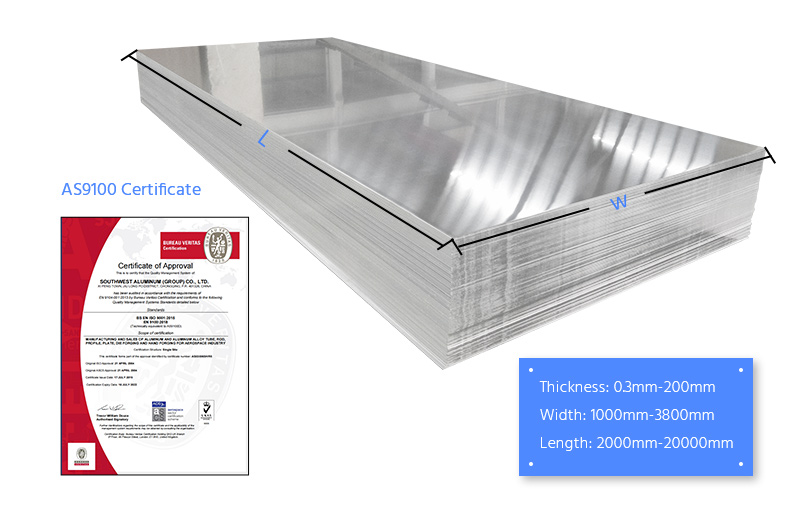
Production thickness: 0.3mm-200mm
Production width: 1000mm-3800mm
Production length: 2000mm-20000mm
Production implementation standards: GB/T3880, GJB1541, GBn167, GJB2053, GJB2662, ASTMB209, ASME SB-209, EN 485, etc., or according to customer requirements.
Application of aerospace aluminum plate in different parts of aircraft
2024 Aerospace Grade Aluminum plate
2024 Aerospace Grade Aluminum plate is a typical alloy in hard aluminum. It has good comprehensive properties, high strength, and certain heat resistance. It can be used for parts that work below 150 ° C. The heat treatment strengthening effect is remarkable, and the corrosion resistance is poor. Aluminum cladding can improve the corrosion resistance.
Temper: O, T3, T361, T4, T72, T81, T861
Typical use: aircraft structure (skin, frame, rib beam, bulkhead, etc.)
2124 Aircraft Grade Aluminum Thick Plate
It is a highly purified alloy of 2024 aluminum alloy. Its strength, plasticity and fracture toughness are better than that of 2024 aluminum alloy, and its SCC performance is similar to that of 2024 aluminum alloy.
Temper: T351, T851
Typical uses: aircraft structural parts, wings, fuselage, gun beams, fuselage skins, central wing skins, air intakes, skins and fairings, etc.
2324 T39 Aircraft Aerospace Grade Aluminum sheet plate
With high strength and high fracture toughness, both thick and thin plates can be produced.
Typical use: aircraft structural parts
2524 T3 Aircraft Grade Aluminum Sheet Plate
When the strength and other properties are comparable to 2024-T3 aluminum alloy, the fatigue strength of the alloy is increased by 10% and the fracture toughness is increased by 20%.
Typical use: aircraft skin
2219 Aerospace Grade Aluminum sheet plate
It has high room temperature strength and high temperature durable strength, good thermoplasticity, no extrusion effect, weldable, poor. corrosion resistance
Temper: T31, T37, T87, T851, T3511
Typical use: aircraft skin and structural parts
7150 T7751, 7055 T7751 Aluminum alloy pre-stretched thick plate
They have high strength and corrosion resistance and are applied to the upper siding of the upper wing.
7075 T7651 Aerospace Aluminum Thick Plate
It has high strength, good toughness, stress resistance and exfoliation corrosion resistance. It belongs to aluminum-zinc-magnesium-copper superhard aluminum alloy.
Typical uses: aircraft frames, integral panels, landing gear, skins, etc.
7055 T77 T7651 Super Hard Aerospace Aluminum Plate
It is the alloy with the highest strength among the deformed aluminum alloys at present. The strength of 7055-T77 alloy sheet is 10% higher than that of 7150 and 30% higher than that of 7075, and it has better fracture toughness and strong resistance to fatigue crack growth.
Typical uses: upper skin on wings, horizontal stabilizer, dragon skeleton, seat rails and cargo rails, etc.
7050 Aluminum Alloy Sheet Plate
It has the characteristics of high strength, good fracture toughness and rehabilitation performance, low quenching sensitivity, etc.
Temper: T7651, T7451, T73511, T76511, T7452
Typical uses: Aircraft fuselage frames, wing skins, bulkheads, stringers, stiffeners, ribs, brackets, landing gear supports, seat rails.
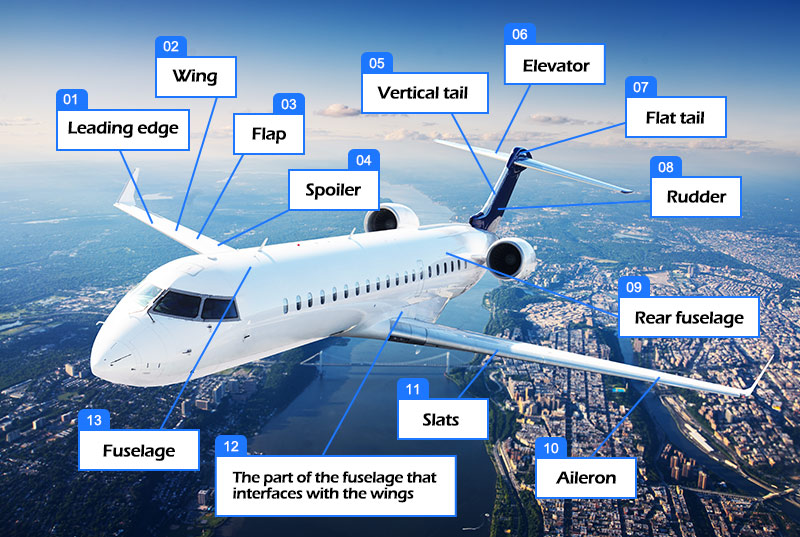
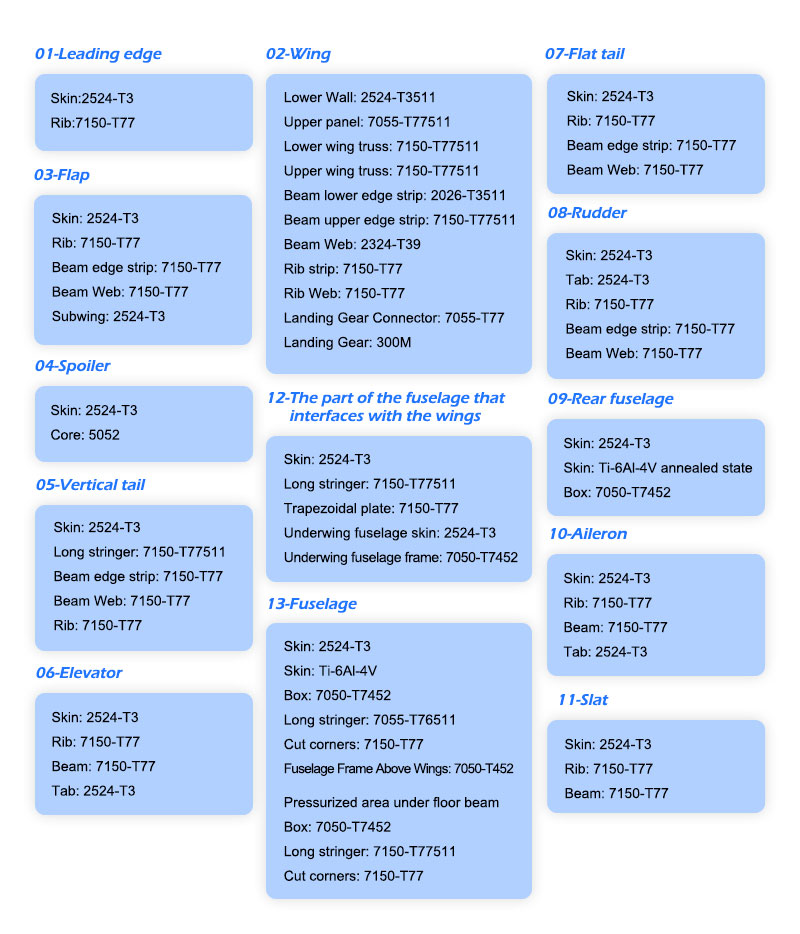
7150 Aerospace Aluminum Plate
It has the characteristics of high strength, excellent corrosion resistance, excellent fracture toughness and fatigue resistance.
Temper: T651, T7751, T6511, T77511, T77
Typical uses: aircraft upper wing structure, body plate beam flange, upper outer plate main wing stringer, fuselage reinforcement.
7175 Aircraft Aerospace Grade Aluminum Sheet Plate
It has the characteristics of high strength, good corrosion resistance, excellent fracture toughness, etc.
Temper: T74, T7452, T76511
Typical uses: aircraft outer spar, main landing gear, nose landing gear action barrel, vertical tail joint.
7475 Aircraft Aerospace Grade Aluminum Sheet Plate
It has the characteristics of high strength, high toughness, good fatigue resistance and corrosion resistance, with good comprehensive properties.
Product and temper: T61, T761, T651, T7651, T7351
Typical uses: aircraft fuselage, wing skins, central wing structures, spars, bulkheads, bulkheads, helicopter decks, landing gear doors.
The application of aluminum forgings in aerospace
Aluminum forgings have a wide range of applications in the aviation industry, and are mainly used to manufacture key components in aircraft that are subjected to alternating loads and concentrated loads. For example, it is used to manufacture the main load-bearing parts such as aircraft fuselage structure, engine rotating parts and landing gear.
Aluminum forgings are also widely used in the aerospace industry. For example, the aluminum forgings used in spacecraft are mainly forged rings, rims, spars and machine bases.

The characteristics of aircraft aerospace grade aluminum forgings
- The density is small, only 34% of steel forgings and 30% of copper forgings, which is an ideal material for lightweight.
- It has high specific strength, high specific stiffness, large specific elastic modulus and high fatigue strength.
- The internal structure is fine, uniform and defect-free, and its reliability is much higher than that of aluminum alloy castings and die castings, and also higher than other material castings.
- The aluminum alloy has good plasticity and can be processed into various high-precision forgings with complex shapes. The machining allowance is small, only about 20% of the machining allowance of the aluminum alloy drawing thick plate, which greatly saves man-hours and costs.
- Aluminum forgings have good corrosion resistance, thermal conductivity and non-magnetic properties, which are incomparable to steel forgings.
- The surface is smooth and beautiful, the surface treatment performance is good, beautiful and durable.
The main applications of aircraft aerospace grade aluminum forgings
2024 T6 2124 T6 2424 T6 High Strength Aerospace Grade Aluminum Forgings
It is a typical hard aluminum alloy with good forgeability, good plasticity and poor corrosion resistance.
Typical use: aircraft parts
7075 T6 7175 T6 7475 T6 High Strength Aerospace Grade Aluminum Forgings
It is a kind of super hard forged alloy, resistant to stress corrosion and poor crack resistance.
Typical uses: aircraft parts, aerospace materials
7075 T73 7475 T73 High Strength Aircraft Aerospace Grade Aluminum Forgings
The stress corrosion cracking resistance is improved by proper aging treatment, and the strength is lower than T6.
Typical use: aircraft parts
7175 T736 High Strength Aircraft Aerospace Grade Aluminum Forgings
It is a new alloy whose strength, toughness and stress corrosion crack resistance are better than 7075 T6.
Typical use: aircraft parts
7050 T73 7150 T73 7055 T73 7155 T79 7068 T77 High Strength Aircraft Grade Aluminum Forgings
A series of new alloys with high strength, high toughness and high resistance to stress corrosion cracking, the comprehensive performance is better than 7075 and 7475-T73.
Typical use: used for high-stress parts, especially key parts of large aircraft and aerospace materials and important structural materials.
7085 Aircraft Aerospace Grade Aluminum forgings
High-strength forged aluminum alloy, high comprehensive performance, suitable for large-section products.
Temper: T7651
Typical Uses: Stringers
2219 T6 Heat-resistant Aircraft Grade Aluminum forgings
It maintains excellent strength and creep resistance at high temperature, and has good welding performance.
Typical use: aircraft, rocket parts
2618 T6 Heat-resistant Aircraft Grade Aluminum forgings
It has the excellent high temperature strength.
Typical uses: pistons, supercharger fans, rubber molds, general heat-resistant parts.

4032 T6 Heat Resistant Aluminum Alloy Forgings
It has high strength at medium temperature, small thermal expansion coefficient and good wear resistance.
Typical uses: Pistons and wear parts
6061 T6 6082 T6 6070 T6 6013 T6 Corrosion Resistant Aircraft Grade Aluminum Forgings
It has medium strength, corrosion resistance, fatigue resistance and comprehensive performance.
Typical Use: Aerospace Components
The application of al-li alloy materials in aerospace
The introduction of al-li alloy materials
Due to its outstanding low density, excellent comprehensive properties and broad application prospects, AL-Li alloy materials have gradually become a new generation of high-performance aluminum alloys that are used in parallel with 2000 and 7000 series alloys in aerospace.
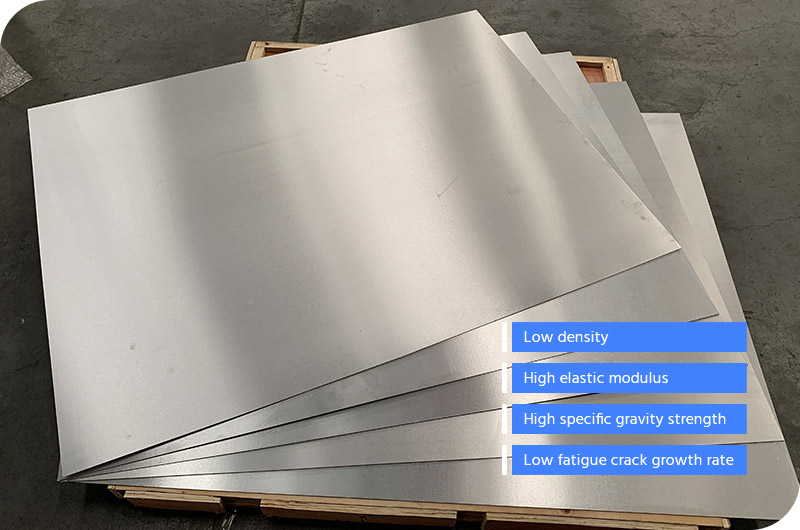
The specifications of aluminum lithium alloy materials
Main alloys: 1420, 2090, 2091, 2195, 2198, etc.
The most widely used alloy grades are 2195-T8X, 2055-T84, 2098-T8X, 2099, etc.
The density of such alloys is generally between 2.6~2.7 g/cm3.
The material strength reaches 600 MPa or higher, and the compressive modulus is 75~79 GPa,
The specific stiffness is between 26~30 GPa ⋅ cm3/g.
The characteristics of Al-Li alloy materials
- low density
- Li is the lightest metal element next to H and He, and its specific gravity is one-fifth of that of Al.
- High modulus of elasticity
- The addition of Cr, Si, Mn, Ti, Li, Cu, Ag and other alloying elements to the aluminum alloy can increase the elastic modulus, and the effect of Li is the most significant.
- High specific gravity
- Good high temperature and low temperature performance
- Low fatigue crack growth rate
- Good corrosion resistance
- Good processability
The main application components of AL-Li alloy materials
The front fuselage skin, nose skin, middle fuselage skin, and middle rear fuselage skin are made of 2198-T8 Aluminum lithium alloy thick plate and Al-Li-S4-T8 aluminum-lithium alloy thick plate manufacture.
The main alloy grades involved are 2060-T8E30, 2198-T8, 2199-T8E74, etc.
The front fuselage girders, nose girders, middle fuselage girders, floor beams, pillars, seat rails are made of 2196-T8511/2099-T83 aluminum-lithium alloy extrusion materials, etc.
High-strength and toughened wing panels or internal load-bearing parts, the main alloy grades involved are 2050-T84, 2055-T8X, 2199-T86, 2060-T8X, etc.
The girders of the middle and rear fuselage are made of 2196-T8511/2099-T83 aluminum-lithium alloy extrusion materials, and the materials used for floor beams and pillars are 2099-T83, 2196-T8511 aluminum-lithium alloy extrusion materials.
Low-density guide rails or load-bearing parts, the alloy grades involved are 2196-T8X, 2099-T81, 1420, 2055, etc.

The application of aluminum profiles in aerospace
Introduction to the Application of Aluminum Profiles in Aerospace
Aluminum profiles can be widely used in the aerospace field as large-scale structural bearing parts. Such as aircraft fuselage frames, stringers, stiffeners, ribs, bracket bulkheads, etc.
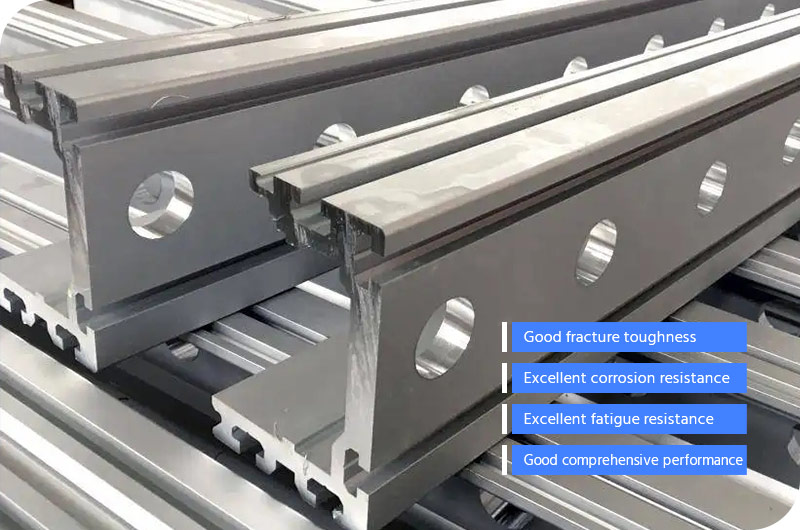
The main application of aluminum profiles in aerospace
2024 Aircraft Aerospace Grade Aluminum profile
A typical alloy in duralumin, with good comprehensive properties.
Typical use: aircraft frame, rib beam, bulkhead, etc.
7050 Aircraft Aerospace Grade Aluminum profile
High strength, good fracture toughness and rehabilitation performance, low quenching sensitivity.
Typical uses: Aircraft fuselage frames, stringers, stiffeners, ribs, brackets, landing gear support parts, seat rails, etc.
7150 Aircraft Aerospace Grade Aluminum profile
High strength, excellent corrosion resistance, excellent fracture toughness and fatigue resistance.
Typical uses: Wing spars, fuselage stringers, fuselage frames, bulkheads, upper wing stringers, ribs and spars, etc.

7175 Aircraft Aerospace Grade Aluminum profile
High strength, good corrosion resistance, excellent fracture toughness.
Typical use: aircraft outer spar, etc.
7475 Aircraft Aerospace Grade Aluminum profile
High strength, high toughness, good fatigue resistance and corrosion resistance, with good comprehensive properties.
Typical use: aircraft fuselage, central wing structure, wing spars, etc.
The application of aluminum foil in aerospace
Honeycomb aluminum structures are fabricated from aluminum foils and have been successfully used in aircraft manufacturing.
Aluminum foil used in aerospace:
5052 aluminum foil
Temper: O, H14, H16, H18, H22, H24
Thickness: 0.03-0.2mm
Width: 100-1700mm
Typical use: honeycomb aluminum structure
3003 aluminum foil
Temper: O, H14, H16, H18, H22, H24
Thickness: 0.006-0.2mm
Width: 100-1700mm
Typical use: honeycomb aluminum structure

The application of aluminum foam in aerospace
Introduction of foam aluminum
Aluminum foam is composed of a small amount of aluminum or aluminum alloy metal skeleton and a large number of pores, and is a new material with macroscopic symmetry breaking.
The performance characteristics of foam aluminum
- The density (p) is small. At p=63%, p=1; at p=80%, p=0.54; at p=90%, p=0.27;
- It has high specific strength and specific stiffness, and its mechanical properties are stable and isotropic;
- It has high damping and vibration reduction and impact energy absorption capacity;
- Excellent acoustic performance;
- Sound insulation: The sound insulation performance of closed cells (thickness 20~30mm) reaches 800~4000Hz.Above 0.9, about 10dB;
- Sound absorption (micro through holes and through holes): The sound absorption coefficient at 2000~4000Hz can reach 0.8, about 7dB;
- Excellent electromagnetic shielding performance. 5mm thick closed-cell aluminum foam with 90% porosity for electromagnetic shielding at 60~1000MHz;
- The performance is 35~75dB;
- Thermal insulation (closed cells, 80~90% porosity, thermal insulation performance is close to marble) and heat dissipation (through-hole forced convection) performance is good.
The versatility of the above properties is compatible.
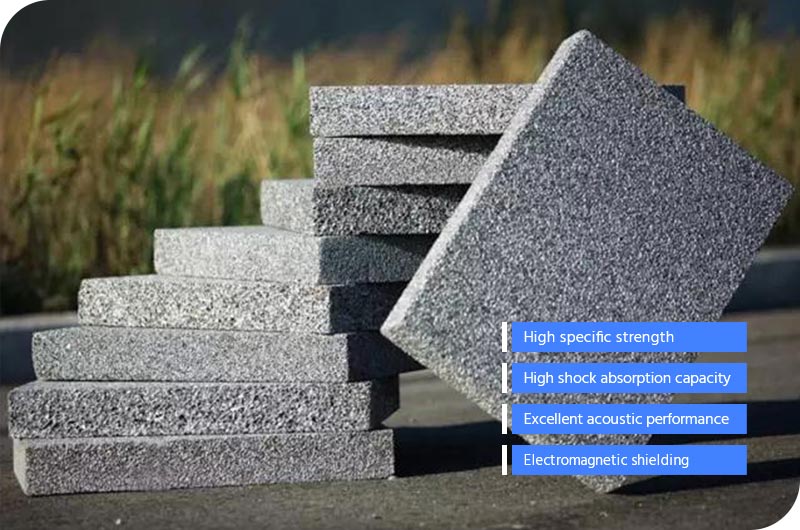
The application of aluminum foam in aerospace
- Anti-vibration seat
- impact resistant bilge
- Gyro Stand
- Non-load-bearing parts or sub-load-bearing parts in space stations and some large spacecraft, such as heat sinks, heat insulation parts, partitions, hatches, etc., are expected to replace existing materials with this material.

Why choose Aiboer?
As an Aircraft Aerospace Grade Aluminum supplier, Aiboer provides superior quality aerospace materials, the best technical service in the market, and has deep knowledge of how to support customers in meeting future challenges.
We have a complete set of domestic advanced aerospace materials research and development, testing and analysis instruments, which guarantee the efficiency of new product research and development and accelerate the transformation of scientific and technological achievements. In addition, our R&D & Innovation and Validation capabilities can help enhance our customers' competitiveness by saving time and costs in new product development and marketing.
We have passed the AS9100 certification required by the aviation industry, which provides a strong guarantee for the quality of the aerospace materials produced by our company.
The Aiboer brand stands for quality, delivery and a strong reputation. With leading technology and globally competitive products, we can continue to develop together with our customers in the future.
